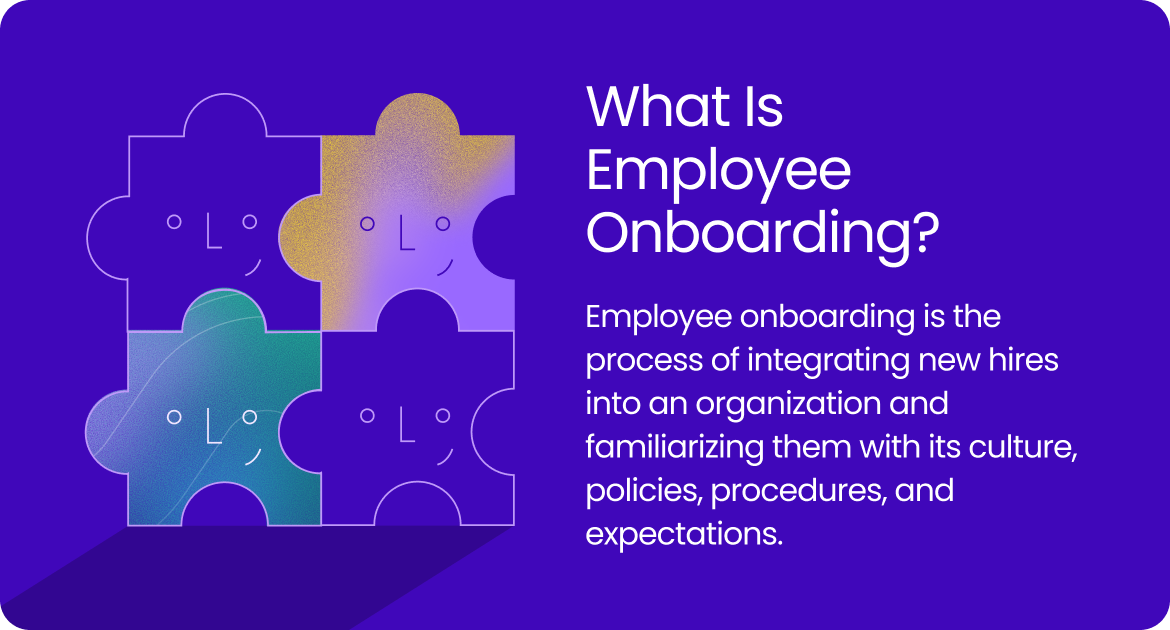As a business owner or human resources manager, you may come across the term "employee onboarding," which refers to the process of integrating new hires into your organization. This process involves providing them with the necessary information, training, and support to become effective and satisfied team members. Understanding employee onboarding is important because a well-structured onboarding program can enhance employee engagement, boost productivity, and reduce turnover rates.
For example, a company might implement a comprehensive onboarding program that includes an orientation session to introduce new employees to the organization's culture and values, detailed training on job-specific tasks, and assigning a mentor to guide them through their initial weeks. This structured approach helps new hires feel welcomed and supported, enabling them to contribute effectively to the organization's success.

Creating an Employee Onboarding Program
A well-structured onboarding program is essential for ensuring new employees transition smoothly into their roles, understand company expectations and employee benefits, and feel valued from day one. Designing an effective onboarding process involves a combination of preparation, engagement, and continuous support to set employees up for long-term success.
The foundation of a strong onboarding program starts with defining clear objectives. Companies must determine what they want employees to achieve at each stage of onboarding; whether it’s understanding company values, mastering job responsibilities, or becoming fully integrated into their team. This structured approach helps create a seamless journey that reduces uncertainty for new hires and ensures consistency across departments.
Key Components of Employee Onboarding
A comprehensive employee onboarding process is vital for integrating new hires effectively, enhancing their productivity, and fostering long-term commitment. This guide outlines a structured onboarding timeline, detailing key activities and considerations from preboarding through the first year of employment.
Preboarding: Preparing for the New Hire's Arrival
Objective: Ensure all necessary preparations are in place before the new employee's first day to facilitate a smooth transition.
Key Actions:
- Administrative Preparation:
- Complete all required paperwork, including tax forms, employment contracts, and benefits enrollment.
- Set up the employee's workstation, ensuring all equipment and access credentials are ready.
- Communication:
- Send a welcome email outlining first-day logistics, dress code, and any materials they should bring.
- Provide an organizational chart and team contact information.
- Engagement:
- Assign a mentor or buddy to assist the new hire during their initial period.
- Share company culture materials, such as mission statements and core values.
First Day: Welcoming and Orienting the New Employee
Objective: Introduce the new hire to the company environment, culture, and immediate team members.
Key Actions:
- Orientation Session:
- Conduct a comprehensive overview of the company's history, mission, values, and organizational structure.
- Review key policies, procedures, and compliance requirements.
- Facility Tour:
- Guide the new employee through the workplace, highlighting essential areas such as restrooms, break rooms, and emergency exits.
- Introductions:
- Facilitate introductions to team members and key personnel.
- Schedule a team lunch or informal gathering to foster initial relationships.
First Week: Establishing Role Clarity and Expectations
Objective: Provide the new hire with a clear understanding of their role, responsibilities, and performance expectations.
Key Actions:
- Training and Development:
- Deliver job-specific training sessions, including hands-on tasks and shadowing opportunities.
- Introduce relevant tools, software, and resources necessary for the role.
- Goal Setting:
- Collaborate with the employee to establish short-term objectives and key performance indicators (KPIs).
- Outline the evaluation process and criteria for success.
- Regular Check-Ins:
- Schedule daily or bi-weekly meetings to address questions, provide feedback, and assess initial progress.
First 90 Days: Fostering Integration and Engagement
Objective: Support the new hire's transition into a fully contributing team member through continuous feedback and development opportunities.
Key Actions:
- Performance Reviews:
- Conduct formal evaluations at 30, 60, and 90-day intervals to discuss achievements, challenges, and areas for improvement.
- Ongoing Training:
- Offer advanced training sessions to build upon initial learning and address specific skill gaps.
- Mentorship and Networking:
- Encourage participation in company events, professional groups, and cross-departmental projects to expand internal networks.
First Year: Promoting Long-Term Success and Retention
Objective: Ensure the employee remains engaged, motivated, and aligned with the company's goals and values.
Key Actions:
- Career Development Planning:
- Work with the employee to identify long-term career aspirations and create a personalized development plan.
- Recognition and Rewards:
- Acknowledge significant contributions and milestones through formal recognition programs or incentives.
- Feedback Loop:
- Solicit feedback on the onboarding experience to inform and enhance future processes.
By adhering to this structured onboarding timeline, organizations can effectively integrate new employees, fostering a positive work environment that promotes productivity and long-term retention.
Benefits of Effective Employee Onboarding
Effective employee onboarding offers numerous benefits for both employees and organizations, including:
- Faster Time to Productivity: Well-planned onboarding programs help new hires acclimate to their roles more quickly, reducing the time it takes to become fully productive.
- Improved Engagement and Retention: Engaging onboarding experiences make new employees feel welcome and valued, increasing their likelihood of staying with the organization long-term and improving your retention startegy.
- Enhanced Job Satisfaction: Clear expectations, support, and resources provided during onboarding contribute to job satisfaction and morale.
- Better Performance and Results: Properly onboarded employees are better equipped to perform their roles effectively, leading to improved performance and business outcomes.
- Positive Employer Branding: A positive onboarding experience enhances the organization's reputation as an employer of choice, attracting top talent and enhancing employer branding efforts.
Best Practices for Employee Onboarding
A well-executed onboarding process can significantly impact employee satisfaction, productivity, and retention. Organizations that take a strategic approach to onboarding help new hires integrate seamlessly into their roles while reinforcing company culture and expectations. Implementing best practices ensures that employees feel engaged and supported from day one, setting the foundation for long-term success.
Start the Onboarding Process Before Day One
Onboarding should begin long before an employee’s first day. Providing new hires with essential documents, company policies, and a clear outline of their first-week schedule helps eliminate uncertainty and allows them to start with confidence. A welcome email from leadership or their direct manager can introduce them to company values, highlight key resources, and set expectations for their role. Companies that go a step further by offering early access to onboarding portals or assigning a mentor before the start date create an even smoother transition.
Make the First Day Welcoming and Productive
The first day at a new job can be overwhelming, and a structured onboarding plan ensures employees feel valued and prepared. Setting up workstations, providing necessary tools and credentials, and offering a comprehensive orientation help eliminate first-day frustrations. Beyond logistics, fostering human connections is equally important. Scheduling team introductions, a welcome lunch, or virtual meet-and-greet sessions helps new employees feel included from the start. Companies that integrate culture-focused sessions early on create a sense of belonging, reinforcing their mission and core values.
Provide Clear Role Expectations and Training
One of the most common challenges new employees face is a lack of clarity regarding their responsibilities. Effective onboarding programs set clear expectations by outlining key performance goals, job responsibilities, and success metrics from the beginning. Training should be structured to introduce employees to company tools, workflows, and industry best practices. Interactive learning methods, such as hands-on training, mentorship, and shadowing experienced colleagues, help employees gain confidence in their roles more quickly. Regular check-ins with managers ensure that employees receive feedback and have opportunities to ask questions as they adjust to their new position.
Ensure Ongoing Engagement Beyond the First Month
A successful onboarding process extends beyond the first few weeks, incorporating continuous learning and engagement. Managers should schedule regular performance discussions at 30, 60, and 90-day intervals to address progress, challenges, and professional development opportunities. Encouraging new employees to participate in company initiatives, networking events, and employee resource groups helps them build connections and feel more integrated into the organization. By maintaining open communication and offering long-term support, companies can foster a work environment that promotes employee growth and retention.
Automating Employee Onboarding with Playroll
Modern businesses are increasingly turning to automation to streamline the onboarding process, reducing administrative burdens and enhancing the new hire experience. Traditional onboarding can be time-consuming, requiring HR teams to manually handle contracts, benefits enrollment, compliance documentation, and payroll setup. Automating these processes with Playroll ensures a seamless, efficient, and compliant onboarding experience—whether you're hiring locally or managing a global workforce.
Key Benefits of Automating Onboarding with Playroll
- Faster Onboarding, Less Paperwork: Playroll automates contract generation, tax compliance, and benefits enrollment, ensuring that new hires can complete preboarding tasks online before their first day.
- Seamless Payroll Integration: Instead of manually setting up payroll for each employee, Playroll connects with multiple payroll providers, ensuring accurate and timely payments across different regions.
- Compliance and Risk Management: Hiring internationally? Playroll ensures compliance with local labor laws, tax regulations, and statutory benefits, reducing the risk of misclassification or legal penalties.
- Centralized Employee Data: Playroll acts as a single source of truth for employee information, integrating with HR tools to provide visibility into onboarding progress, documentation status, and employee milestones.
- Enhanced Employee Experience: A smooth, digital-first onboarding process reduces friction for new hires, providing them with self-service access to employment details, policies, and training resources.
How Playroll Fits into the Onboarding Timeline
- Preboarding: Automate employment contracts, tax forms, and payroll setup, so employees are fully prepared before their start date.
- First Day: Grant instant access to onboarding portals, company policies, and compliance training with minimal manual intervention.
- First Week: Automate check-ins, assign training modules, and integrate payroll to ensure employees are fully onboarded.
- First 90 Days & Beyond: Maintain compliance, automate benefits administration, and track performance milestones with centralized reporting.
By leveraging Playroll to automate employee onboarding, businesses can save time, improve accuracy, and ensure a compliant, engaging onboarding experience; setting employees up for long-term success.
Employee Onboarding FAQs
How long should the onboarding process last?
The duration of the onboarding process varies depending on factors such as the complexity of the role, the organization's size and structure, and the onboarding approach. Typically, onboarding programs last from a few days to several months.
What are some common onboarding challenges?
Common onboarding challenges include lack of consistency, poor communication, insufficient resources, overload of information, and disengagement. Addressing these challenges requires careful planning, effective communication, and ongoing evaluation and adjustment of onboarding programs.
How can technology enhance the onboarding experience?
Technology can automate administrative tasks, deliver personalized training content, facilitate virtual interactions, and track onboarding progress, making the process more efficient, engaging, and scalable. By leveraging technology, organizations can create seamless and immersive onboarding experiences for new hires.
.svg)
.svg)
.svg)
.svg)
.svg)





.svg)



.png)


.png)

.svg)



















.svg)